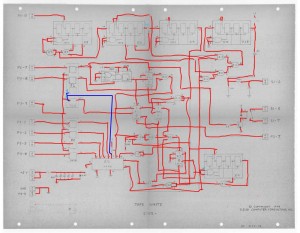I’ve started working on building up a second set of the “core” SCELBI boards. I call the boards that are shared between the SCELBI 8B and 8H, the “core” boards. These are the front panel, the cpu, the DBB, and the input boards. When I built my prototype 8B, I didn’t bother to make new “core” boards, I just borrowed them from my 8H. Now that I have a new set of the “core” PCBs in stock, I figured that I would make up a second set, so that I could run both the 8H and 8B at the same time.
As part of the building of these new boards, I figured I’d use the 8B manual that I am in the process of digitizing. Yesterday, after completing the front panel board, I discoved that all my LEDs were installed backwards. The manual states:
The anode of the L.E.D. (shorter lead) goes in the top most hole (furthest away from the card connector). The cathode of the L.E.D. (longer lead) goes in the bottom hole.
This is actually the reverse of how LEDs are made – the cathode has the shorter lead, not the anode. I didn’t encounter this issue when building the board for my 8H, because the 8H front panel instructions were written for the old style LEDs in the cans, so I had to figure out the right way to connect them without benefit of the SCELBI manual. You would think that with all the projects that I’ve done, that I would remember how LED’s are constructed and connected. However pinouts are the sorts of details that are easily found in reference material, so I don’t put any effort into memorizing pinouts of anything.
As far as the newly digitized manual goes, one of my intentions is to add content and clarification when it is missing, but maintain the “character” of the original manual. I think, in this case, I will correct the text and add a footnote that explains how the original manual was wrong.


